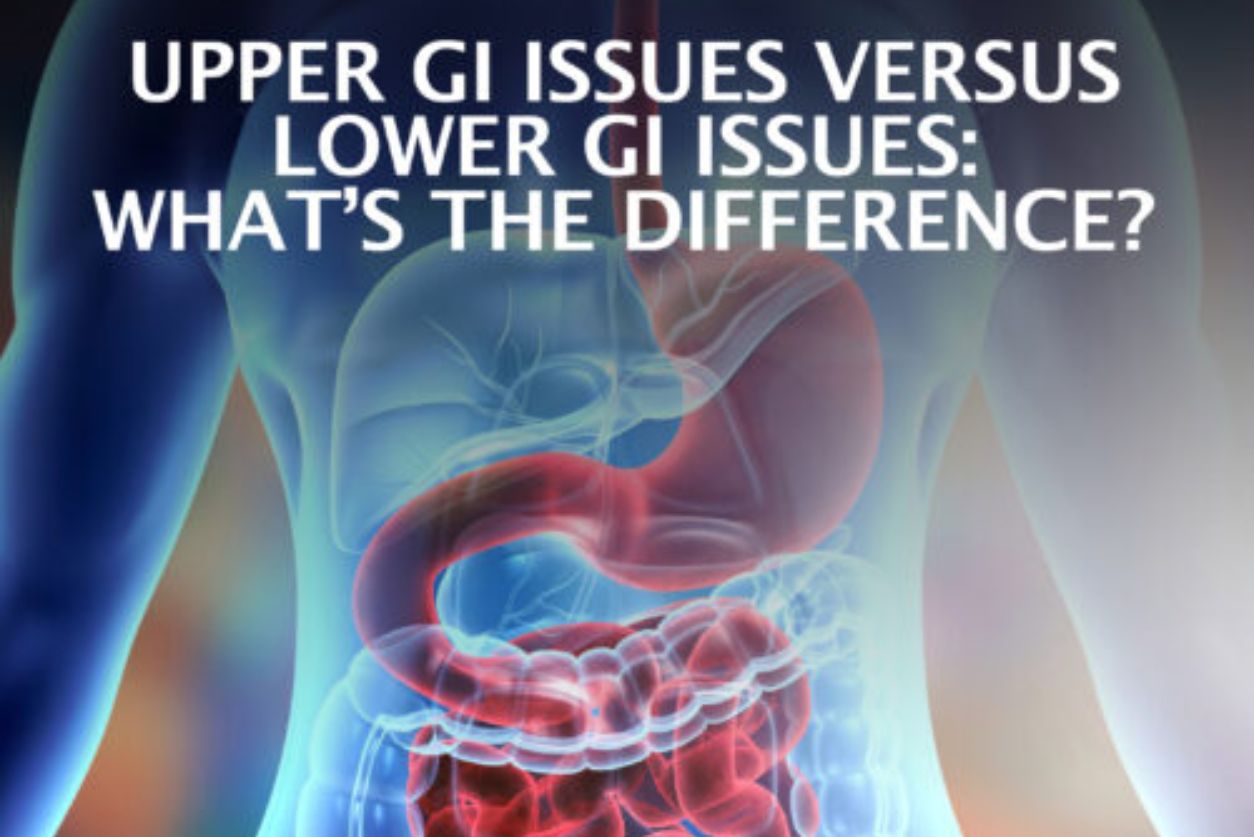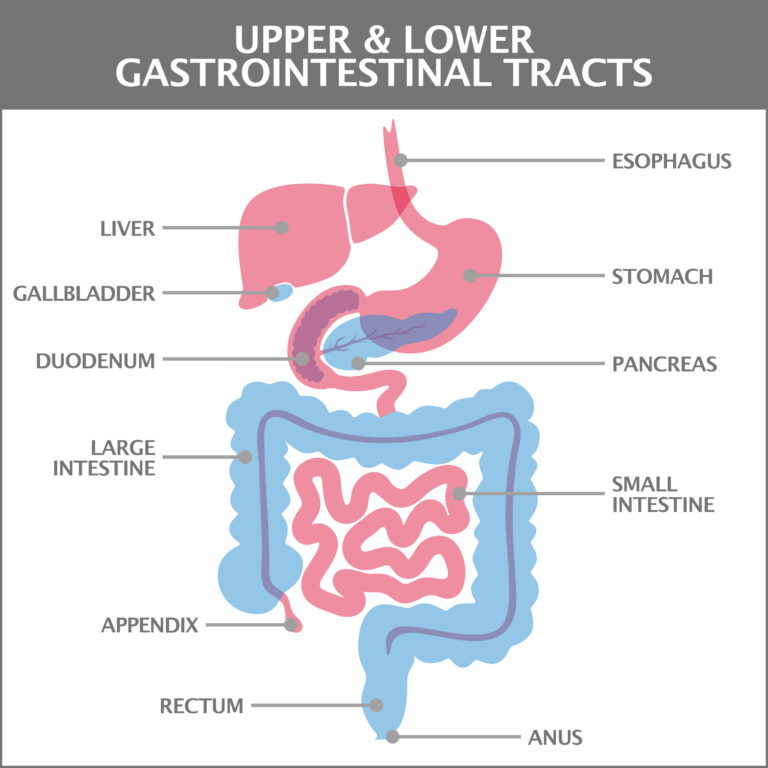
Upper GI Issues Versus Lower GI Issues: What’s The Difference?
The gastrointestinal system is a complicated network of cells, tissues, and organs that are responsibilities for:
- Digesting the foods and beverages you eat.
- Processing the nutrients in your body.
- Eliminating waste products.
When any part of this network experiences injury or illness, you can develop many symptoms ranging from annoying to life-threatening.
Gastrointestinal Tract Sections
The digestive system is so large and complex that doctors divide it into upper and lower gastrointestinal tracts. Often, they are abbreviated as the Upper and Lower GI.

The Upper GI
The upper gastrointestinal tract begins with the mouth, extends through the esophagus, and passes through the stomach and the small intestine’s most upward section known as the duodenum.
The mouth is where you break down and swallow foods and beverages. Foods are separated into smaller particles, then they travel down a passage known as the esophagus. The esophagus brings these materials into the stomach. The stomach begins the major digestive processes before dumping further digested byproducts into the small intestine.
The Lower GI
The lower GI begins in the southern region of the small intestine, continues through the large intestine (colon), into the rectum, and out the anus. The gallbladder, pancreas, and liver are essential organs in this section.
- The vitamins and minerals found in food are broken down in the small intestine’s lower region. The colon processes and stores waste products transported to the rectum and expelled through your anus.
- The gallbladder stores essential digestive juices like bile.
- The pancreas aids in the digestive process and secretes an important digestive and metabolic hormone called insulin.
- The liver processes a significant amount of waste produced during the digestive process. It also produces hormones and other essential substances.
Upper GI Illnesses
Common Upper GI problems include:
- Upper abdominal pain and discomfort (known as dyspepsia).
- Gastroesophageal reflux disease (abbreviated as GERD).
- Gastroparesis (when the stomach takes a long time to empty its contents).
- Gastritis (characterized by inflammation of the stomach’s lining).
- Peptic and duodenal ulcers (sores developing inside the stomach or duodenum).
- Inflammation of the esophagus (known as esophagitis).
- Swallowing disorders.
- Infections like the H-pylori bacteria.
In a smaller percentage of cases, cancer can impact various sections of the upper GI.
Lower GI Concerns
Common Lower GI problems include:
- Irritable bowel syndrome.
- Inflammatory bowel diseases (like Crohn’s and ulcerative colitis).
- Infections within portions of the lower small intestine (known as diverticulitis).
- Hemorrhoids.
Colon and rectal cancer are also relatively common but serious illnesses striking the lower GI.
Symptoms Of Upper GI Issues
Symptoms of upper GI issues can vary depending on the illness and how advanced the disease is. These conditions often have common signs like:
- Heartburn.
- Burping.
- Gas.
- Upper abdominal pain.
- Nausea.
- Vomiting.
- Swallowing difficulties.
More severe illnesses like cancer can lead to weight loss, fatigue, and appetite loss. Also, advanced ulcers can cause you to spit up blood that resembles black coffee grinds.
Lower GI Symptoms
Like the conditions impacting the upper GI, lower GI symptoms can vary from person to person and range in severity. These conditions also produce common symptoms like:
- Diarrhea.
- Constipation.
- Bloating.
- Lower abdominal pain.
- Pain in the anal region, making actions like sitting uncomfortable.
Serious lower GI problems like cancer might cause significant concerns like intestinal blockages or bleeding. Bleeding usually appears as black, tarry stools. Streaks of bright red might be found in the bowel movements of people with rectal or anal problems like fissures or hemorrhoids.
In some cases, blood in the stool can also show an upper GI problem (where blood has traveled down the entire network).
Diagnosing Upper and Lower GI Ailments
Regardless of where the suspected problem stems from, the diagnostic process used to identify it is the same.
Your gastroenterologist will start by asking you questions such as:
- When did your symptoms begin?
- Does eating or drinking make the problems worse?
- Were the symptoms accompanied by more severe issues like fatigue, weight loss, or a decreased appetite?
Your doctor will then examine parts of your gastrointestinal network, looking for noticeable abnormalities.
If your gastroenterologist thinks you might have a severe digestive disorder or problem requiring more aggressive treatment, they will order internal diagnostic tests. The test type will vary depending on whether the problem affects the lower or upper GI.
Upper GI Internal Imaging Tests
The Upper GI Series is the most common internal imaging test used to diagnose upper GI issues. This test requires you to drink a chalky beverage that includes barium, which illuminates during X-rays. This process allows your doctor to detect any problems and do a more thorough internal examination.
An endoscopy is a tiny tube-like camera (endoscope) that is inserted into your mouth and down your throat. The images captured by the camera are then transmitted to a computer to identify any problems.
Additional procedures used to diagnose upper GI disorders include:
- pH monitoring.
- Ultrasound.
- Manometry.
Lower GI Imaging Tests
A colonoscopy is the most common internal imaging test for detecting lower GI diseases. During this process, you undergo sedation before medical teams insert a colonoscope apparatus into your rectum and extend it through your colon. The device contains a camera that sends these pictures to a computer for diagnostic purposes.
Aside from colonoscopy, doctors might also recommend:
- A flexible sigmoidoscopy (a test that examines only the rectum and lower region of the colon).
- A capsule endoscopy.
- An anorectal manometry.
- Tissue biopsies.
- Various stool samples.
- Blood tests.
- Magnetic Resonance Imaging (MRI).
Potential Treatment Options
The treatment protocol chosen by your gastroenterologist will depend on several factors, such as your age, overall health, the underlying condition, and the severity of the disorder.
Less serious and manageable conditions might notice improvement after using over-the-counter or prescription medications like antacids or anti-diarrhea/constipation reversing drugs. Other home remedies might include changing your diet, quitting smoking, and drinking excessively, or taking probiotic supplements.
More serious or aggressive illnesses might need more powerful prescription drugs or surgery.
Preventing Gastrointestinal Problems
Not every problem can be prevented. You can lessen your risk by engaging in preventative measures like:
- Eating a nutritious and balanced diet (free of fatty, greasy, processed, canned, or frozen products).
- Staying hydrated.
- Quitting smoking.
- Reducing alcohol intake.
- Exercising regularly.
Above all, you are urged to continue routine medical care. Consistent and thorough exams can help doctors identify issues in their earliest and most treatable stages.
Contacting Us
Our practice began more than 15 years ago and has emerged as one of the leading gastroenterology practices in central Florida. We perform several diagnostic procedures using state-of-the-art equipment in a friendly, comfortable, and inviting atmosphere. Patient care is always our top priority. Contact us today!